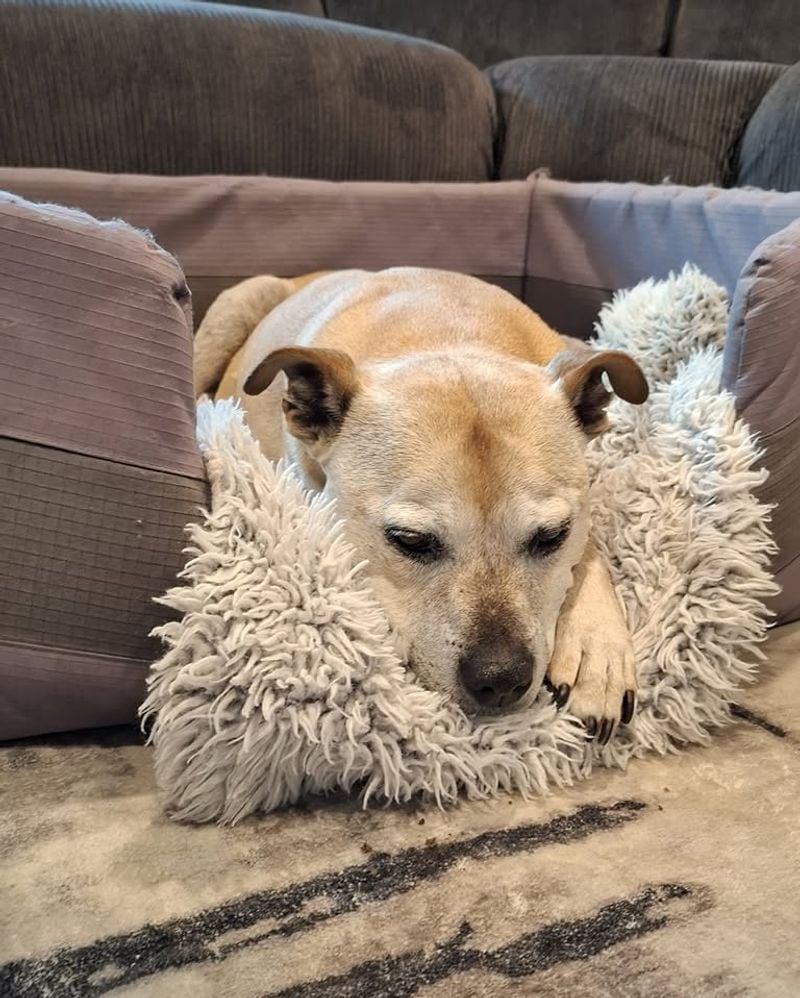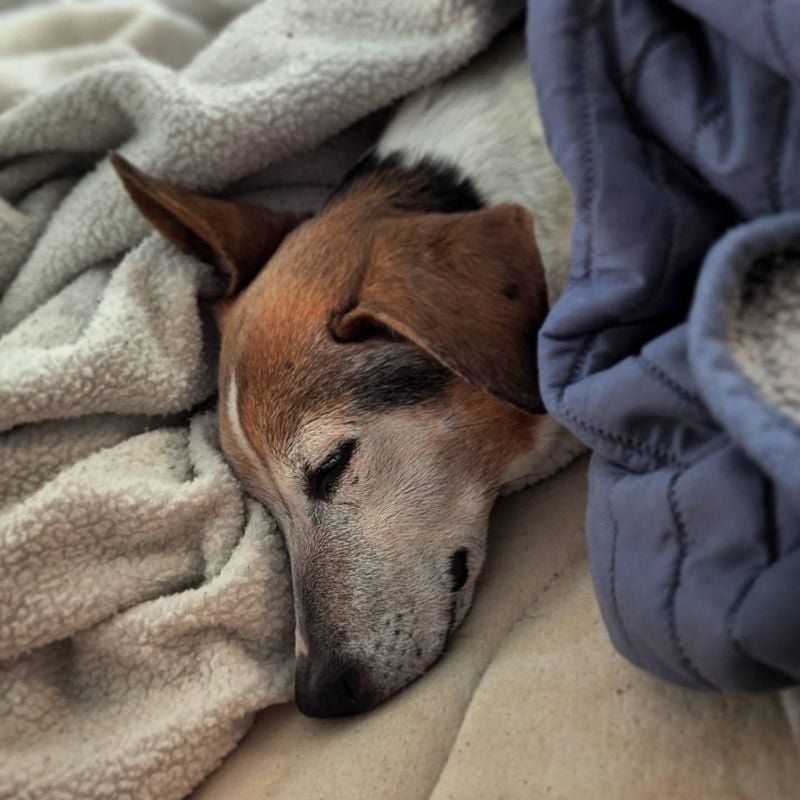14 Subtle Signs Your Dog Is in Pain—Even If They’re Pretending to Be Fine
Your dog can’t tell you they’re hurting—but that doesn’t mean they aren’t.
Dogs are instinctively wired to mask pain. In the wild, showing weakness could mean the difference between survival and becoming prey.
Even though your dog lives a cozy life far from predators, that evolutionary instinct remains. So while you’re going about your day, your beloved pup might be suffering in silence, hoping you’ll notice, even when they work hard to hide it.
It’s easy to assume that if your dog isn’t whining or limping, they must be fine. But in reality, pain in dogs often shows up in ways we don’t expect: a hesitant climb up the stairs, an odd sleeping posture, or a sudden lack of interest in playtime. The clues are subtle—sometimes no more than a change in facial expression or an unusual breath pattern. But once you know what to look for, these signs become impossible to ignore.
As pet parents, we want to believe we’d immediately notice if something was wrong. But the truth is, even the most observant owners can miss these red flags until the pain becomes unbearable. That’s why early detection is everything.
This guide breaks down often-overlooked signs that your dog might be in pain, even if they seem “normal” on the surface. Whether it’s a stiff stance, excessive licking, or a tail that’s just not wagging like it used to, each behavior tells a story. And the sooner you recognize the signals, the sooner you can help your dog get the care they need.
Because no dog should have to suffer in silence, and no owner should have to guess what their best friend is trying to say.
1. Unusual Posture or Stance
Your normally bouncy pup might adopt a prayer position, with front legs on the ground and rear end up, trying to relieve abdominal pain. Some dogs arch their backs or hold their heads below their shoulders when in discomfort.
Watch for a stiff, hunched appearance or reluctance to lie down completely. Dogs experiencing neck or back pain might sleep sitting up or refuse to curl up in their usual sleeping position.
These posture changes often happen gradually, making them easy to miss if you’re not paying close attention to your dog’s normal way of standing, sitting, and lying down.
2. Panting When It’s Not Hot
Excessive panting without physical exertion or heat exposure often signals pain or distress. Your dog might pant heavily while resting in a cool room, something they wouldn’t normally do.
The rhythm of pain-related panting typically differs from normal cooling panting—it might be more shallow, rapid, or irregular. Some dogs will pant with their mouths closed in a grimace-like expression.
Pay special attention if this behavior starts suddenly or persists for more than 30 minutes. Senior dogs might pant more with arthritis pain, especially after getting up from rest.
3. Reluctance to Climb Stairs or Jump
Fido used to race up the stairs but now he hesitates at the bottom, contemplating each step. This sudden change might indicate joint pain, back problems, or muscle soreness.
Dogs experiencing hip or knee pain often develop creative workarounds—scooting up stairs sideways or using furniture as stepping stones to reach higher places. Some might attempt to jump but stop mid-action with a yelp.
Morning reluctance that improves throughout the day suggests arthritis, while consistent avoidance may point to more serious issues like disc problems or ligament tears requiring veterinary attention.
4. Changes in Sleeping Habits
Your dog’s sleeping patterns can reveal hidden pain. A pet who suddenly sleeps more might be trying to heal or avoid movement that causes discomfort. Conversely, decreased sleep could indicate that they can’t find a comfortable position.
Location changes matter too. A dog who always slept on your bed might start preferring the floor where it’s cooler and provides more support for aching joints.
Restlessness at night, frequent position changes, or unusual sleeping postures (like sleeping sitting up) can all signal that something hurts. Monitor these subtle shifts—they often appear before more obvious symptoms.
5. Licking or Focusing on Specific Areas
Excessive licking of a particular spot isn’t just a grooming habit—it’s often your dog’s attempt to soothe pain. The area might become red, irritated, or develop a “lick granuloma,” a raised, hairless patch from constant attention.
Beyond licking, watch for your dog repeatedly touching their nose to a specific body part or staring at an area that hurts. Some dogs will guard painful spots, turning their heads quickly if you reach toward the sensitive region.
Joint areas, paws, and the base of the tail are common focus points. This behavior is particularly telling if it develops suddenly or targets areas previously ignored.
6. Decreased Interest in Play or Walks
Remember how your pup used to bounce with excitement at the sight of their leash? A dog in pain might now watch you prepare for a walk with a blank stare or even walk away.
During playtime, they might engage briefly before quitting or show selective enthusiasm—happily retrieving balls but avoiding tug-of-war that strains their neck or back. Some dogs will still participate, but with noticeably less vigor or endurance.
This reluctance often fluctuates day to day, making it easy to dismiss as “just being lazy.” Track these patterns—consistent decline in activity enthusiasm is a strong indicator that something hurts.
7. Subtle Changes in Facial Expression
A dog’s face speaks volumes about their comfort level. Pain often causes tightened muscles around the eyes and mouth, creating a strained, worried appearance. Their eyes might appear squinted or smaller than usual.
The ears, normally perky and forward-facing in healthy dogs, may flatten or position differently when discomfort strikes. Some dogs develop vertical wrinkles on their foreheads or hold their mouths in unusual positions.
Compare your dog’s current expressions to photos from happier times. These changes can be incredibly subtle—a slight grimace, a tense jaw, or distant gaze—but once noticed, they’re unmistakable signals that your companion isn’t feeling well.
8. Unexpected Aggression When Touched
Your normally gentle companion suddenly snaps when you pet certain areas—this isn’t behavioral regression but likely pain protection. Dogs instinctively guard injured areas, sometimes growling, flinching, or even attempting to bite when sensitive spots are touched.
Watch for subtle warnings before aggression occurs. Many dogs will stiffen, turn their head toward your hand, lick their lips, or show whale eye (whites of eyes visible) when you approach painful regions.
This defensive reaction is often inconsistent and situation-dependent. Your dog might allow touching in relaxed settings but react when the painful area is surprised by a touch or when they’re already stressed.
9. Altered Eating or Drinking Habits
Pain can dramatically affect your dog’s appetite and drinking patterns. Dental pain might cause them to drop food, chew on one side, or suddenly prefer soft foods over kibble. Some dogs with neck or back pain tilt their food bowls or eat in unusual positions.
Decreased water intake might indicate discomfort when bending to drink. Conversely, increased drinking could signal various painful conditions, including diabetes, kidney issues, or certain inflammatory diseases.
Even bowl preference matters—a dog avoiding a raised feeder might have neck pain, while one suddenly preferring elevated dishes might have joint or back discomfort. These subtle mealtime changes often precede more obvious symptoms.
10. Trembling or Shaking Without Cause
Unexplained trembling isn’t always about fear or cold—it frequently signals pain. The shaking might be localized to a specific leg or generalized throughout the body, often intensifying when the painful area is used.
Many dogs experience intermittent trembling that owners mistakenly attribute to age or excitement. The key difference is context: pain-related trembling occurs during normal activities or rest, not just in stressful situations.
Morning tremors that improve with movement suggest arthritis, while sudden shaking episodes might indicate acute pain from injury or internal issues. Always note whether the trembling corresponds with specific movements or positions—this information helps veterinarians pinpoint the problem.
11. Unusual Bathroom Behaviors
Pain often manifests in changed bathroom habits. A perfectly housetrained dog might suddenly have accidents indoors because getting outside requires painful movement. Watch for straining, unusual postures, or vocalizations during elimination.
Dogs with back or hip pain might squat incompletely or wobble while positioning themselves. Some alternate between different elimination postures, trying to find comfort. Male dogs who normally lift their leg might switch to squatting to reduce joint strain.
Frequent attempts with minimal output could indicate urinary tract infections or bladder stones—painful conditions requiring prompt attention. Even subtle changes like spending extra time selecting a spot can reveal discomfort that’s otherwise well-hidden.
12. Reluctance to Wag or Move Their Tail
Your dog’s tail is a barometer for pain, especially back or hip discomfort. A normally expressive tail that hangs limp or moves stiffly suggests something hurts. Some dogs with tail pain hold their tails in unusual positions—either tucked tightly or held slightly away from the body.
During greetings, a dog in pain might show enthusiasm with their face but minimal tail movement. This disconnect between facial eagerness and tail expression is a subtle but important clue.
Limber tail syndrome (swimmer’s tail) causes the tail to hang limply and is painful to the touch. Any sudden change in how your dog carries or moves their tail warrants attention, as it’s rarely just a behavioral change.
13. Unexplained Pacing or Restlessness
A dog who can’t get comfortable—constantly changing positions, pacing, or getting up and down repeatedly—is often experiencing pain they can’t escape. This restlessness frequently intensifies at night when there are fewer distractions from their discomfort.
Some dogs circle their beds multiple times but never settle, while others move from location to location seeking relief. Watch for patterns: restlessness after certain activities suggests injury, while consistent morning agitation points to arthritis or joint issues.
This behavior is often dismissed as anxiety or aging, but it represents a significant warning sign, especially when it develops suddenly. Videoing these episodes can help your veterinarian understand the full extent of your dog’s discomfort.
14. Shallow or Changed Breathing Patterns
Breathing changes often signal pain, particularly in the chest or abdomen. Healthy dogs breathe deeply and evenly, while those in pain might take shallow, rapid breaths to avoid expanding painful areas. Some develop a distinctive grunt or sigh at the end of each breath.
Position-dependent breathing changes are especially telling. A dog who breathes normally while standing but shows labored breathing when lying down might have abdominal pain or fluid accumulation.
Night breathing patterns matter too—dogs with certain painful conditions breathe normally while active but develop irregular patterns during sleep. Record your dog’s breathing if you notice changes—the sound and rhythm provide valuable diagnostic information for veterinarians.




















